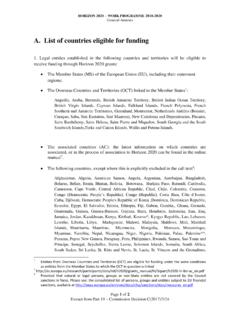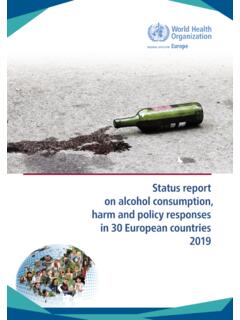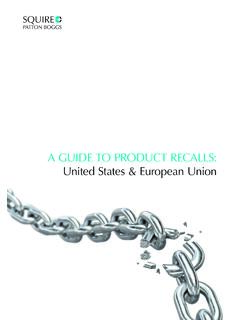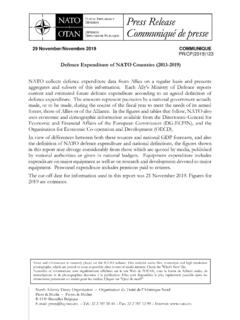Transcription of The European regulatory system for medicines
1 The European regulatory system for medicinesA consistent approach to medicines regulation across the European UnionAn agency of the European UnionThe European regulatory system for medicines A consistent approach to medicines regulation across the European Union EMA/716925/20162 The EU regulatory system for medicinesThe European medicines regulatory system is based on a network of around 50 regulatory authorities from the 31 EEA countries (28 EU Member States plus Iceland, Liechtenstein and Norway), the European Commission and EMA.
2 This network is what makes the EU regulatory system network is supported by a pool of thousands of experts drawn from across Europe, allowing it to source the best possible scientific expertise for the regulation of medicines in the EU and to provide scientific advice of the highest and the Member States cooperate and share expertise in the assessment of new medicines and of new safety information. They also rely on each other for exchange of information in the regulation of medicine, for example regarding the reporting of side effects of medicines , the oversight of clinical trials and the conduct of inspections of medicines manufacturers and compliance with good clinical practice (GCP), good manufacturing practice (GMP), good distribution practice (GDP), and good pharmacovigilance practice (GVP).
3 This works because EU legislation requires that each Member State operates to the same rules and requirements regarding the authorisation and monitoring of systems which connect all parties in the network facilitate the exchange of information on aspects such as safety monitoring of medicines , authorisation and supervision of clinical trials or compliance with good manufacturing and distribution authorisationsTo protect public health and ensure the availability of high quality, safe and effective medicines for European citizens, all medicines must be authorised before they can be placed on the market in the EU.
4 The European system offers different routes for such an authorisation. This booklet explains how the European regulatory system for medicines operates. It describes how medicines are authorised and monitored in the European Union (EU) and how the European medicines regulatory network a partnership between the European Commission, the medicines regulatory authorities in EU Member States and the European Economic Area (EEA), and the European medicines Agency (EMA) works to ensure that patients in the EU have access to high-quality, effective and safe centralised procedure allows the marketing of a medicine on the basis of a single EU-wide assessment and marketing authorisation which is valid throughout the EU.
5 Pharmaceutical companies submit a single authorisation application to EMA. The Agency s Committee for Medicinal Products for Human Use (CHMP) or Committee for Medicinal Products for Veterinary Use (CVMP) then carries out a scientific assessment of the application and gives a recommendation to the European Commission on whether or not to grant a marketing authorisation. Once granted by the European Commission, the centralised marketing authorisation is valid in all EU Member States. The use of the centrally authorised procedure is compulsory for most innovative medicines , including medicines for rare majority of medicines authorised in the EU do not fall within the scope of the centralised procedure but are authorised by national competent authorities (NCAs) in the Member a company wants to authorise a medicine in several Member States, it can use one of the following procedures.
6 The decentralised procedure where companies can apply for the simultaneous authorisation of a medicine in more than one EU Member State if it has not yet been authorised in any EU country and does not fall within the scope of the centralised procedure; the mutual-recognition procedure where companies that have a medicine authorised in one EU Member States can apply for this authorisation to be recognised in other EU countries . This process allows Member States to rely on each other s scientific and requirements applicable to pharmaceuticals in the EU are the same, irrespective of the authorisation route for a medicine.
7 Transparency about how the system works and how it reaches its decisions is an important feature of the EU regulatory system for medicines . A European Public Assessment Report, or EPAR, is published for every human or veterinary medicine that has been granted or refused a marketing authorisation following an assessment by EMA. For a medicine that is authorised by a Member State, details on the assessment of the medicine are also available in a Public Assessment Report. 1. The regulation of medical devices does not fall within the scope of the European regulatory system for medicines .
8 By working closely together, Member States reduce duplication, share the workload and ensure the efficient and effective regulation of medicines across the authorisation routes: one set of common enables one application, one assessment, one market authorisation for the whole of the EU. The diversity of experts involved in the regulation of medicines in the EU encourages the exchange of knowledge, ideas and best practice between scientists striving for the highest standards for medicines European regulatory system for medicines A consistent approach to medicines regulation across the European Union EMA/716925/20163 Pricing and reimbursementOnce a marketing authorisation has been granted.
9 Decisions about price and reimbursement take place at the level of each Member State considering the potential role and use of the medicine in the context of the national health system of that role of the European CommissionThe European Commission plays an important role in the regulation of medicines in the EU. On the basis of scientific assessments carried out by EMA, it grants or refuses, changes or suspends marketing authorisations for medicines that have been submitted via the centralised procedure.
10 It can also take EU-wide action when a safety issue has been identified for a nationally authorised product and when harmonised regulatory measures in all MSs are considered necessary following assessment by EMA s European Commission can also take action concerning other aspects of medicine regulation: Right of initiative it can propose new or amended legislation for the pharmaceutical sector; Implementation it can adopt implementing measures as well as oversee the correct application of EU law on pharmaceuticals; Global outreach it ensures appropriate collaboration with relevant international partners and promotes the EU regulatory system role of EMAEMA is responsible for the scientific evaluation, primarily of innovative and high-technology medicines developed by pharmaceutical companies for use in the EU.















